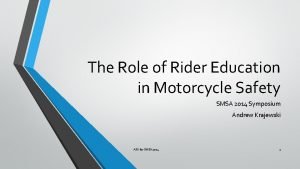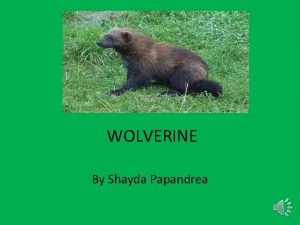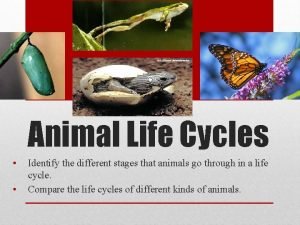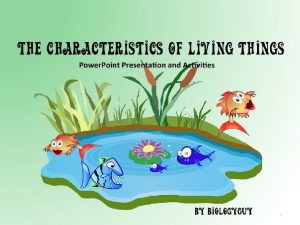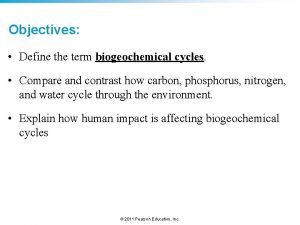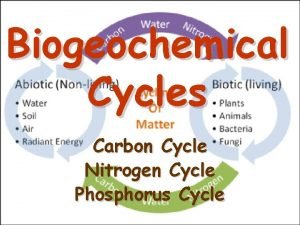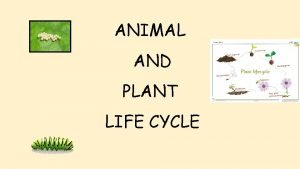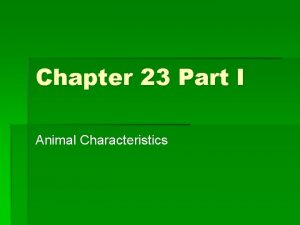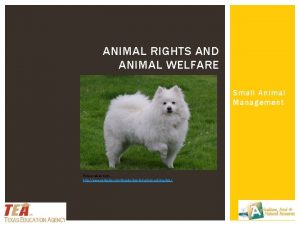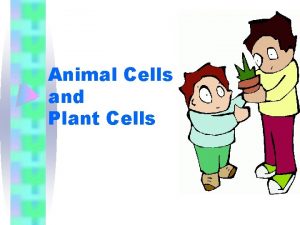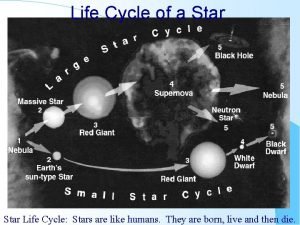Mrs Krajewski ANIMAL STRUCTURE AND LIFE CYCLE CHARACTERISTICS



















- Slides: 19

Mrs. Krajewski ANIMAL STRUCTURE AND LIFE CYCLE

CHARACTERISTICS: � 1. made of cells � 2. They reproduce � 3. They move � 4. They eat food � 5. They grow and change CHARACTERISTICS OF ANIMALS

VERTEBRATES INVERTEBRATES � All animals that have backbones. � Fish, amphibians, retiles, birds, and mammals animals that do not have a backbone. � Arthropods- (insects, crabs, spiders) � � Text p. 22 -23 Answer checkpoint question 1 on p. 23 VERTEBRATES VS. INVERTEBRATES


WARM BLOODED COLD BLOODED � The body of a Warm Blooded animal does not change much. body of a Cold Blooded animal changes depending on their surroundings. WARM BLOODED VS. COLD BLOODED

Animals are classified into different types of groups. : To study the many forms of animal life in a systematic way, scientists have divided the animal kingdom into groups. These groups are largely based upon the structure of the animal's body. Information is from: http: //kids. britannica. com/comptons /article-196401/animal ANIMAL CLASSIFICATIONS � Insects � Amphibians � Mammals � Reptiles � Fish � Birds Open up to textbook p. 18

� Fish are usually covered in scales. They live only in water. Fish breathe mostly by using their gills. Fish are cold blooded and most lay eggs. � There fish: 1. 2. FISH 3. are three classes of the primitive jawless fishes, or Agnatha the cartilaginous (shark like) fishes, or Chondrichthyes the bony fishes, or Osteicht http: //answers. encyclopedia. com/question/three-classes-fish 86809. htmlhyes.

� Amphibians are covered with a smooth skin � They can live on both land in the water. � They breathe by using their gills or with lungs, sometimes even both! � They are cold blooded � They hatch from eggs AMPHIBIANS

� Reptiles are covered in scales � Most reptiles live on land � Some can live in water � They use their lungs to breathe � They are cold blooded � They usually lay eggs REPTILES

� Birds are covered with feathers. � They usually live on land, but some spend a great deal of time on water � Birds breathe using lungs � They are warm blooded � They lay eggs BIRDS

� All mammals have hair or fur � Most live on land, but a few live in water � They use lungs to breathe � Mammals are warm blooded, they control their body temperature � Most mammals have live births MAMMALS

APPLY TO LEARNING � Draw this chart in your copybook and list whether each classification is cold blooded or warm blooded: FISH, AMPHIBIANS, REPTILES, BIRDS, MAMMALS COLD BLOODED WARM BLOODED

MATCH THE PICTURE TO THE CLASSIFICATION Mammal FISH Reptile Bird Amphibian

CREATE A GRAPH � Create a graph that compares the size of animals to the number of young they bear. Size Small. Medium. Large- Animal Number of Young

LIFE CYCLES OF ANIMALS Animals have a variety of life cycles. Each life cycle depends on the species and can vary greatly. Let’s read pages 20 and 21 together!

ee s ’s Let e s! m e o l s p m a ex



RESEARCH: WHAT IS THE AVERAGE LIFE SPAN OF EACH ANIMAL? Animal Dog Human Fish Monkey Fruit Fly Your choice: ______ Life Span (average)
 Prof. mirosław krajewski
Prof. mirosław krajewski Prof. wojciech krajewski
Prof. wojciech krajewski Andy krajewski
Andy krajewski They are mrs garcia and mrs castro
They are mrs garcia and mrs castro They are mrs garcia and mrs castro
They are mrs garcia and mrs castro Mrs gren c
Mrs gren c Mrs. darling was ___________ of mrs. s.
Mrs. darling was ___________ of mrs. s. Wolverine's life cycle
Wolverine's life cycle Animal life cycle stages
Animal life cycle stages The life cycle of a black panther
The life cycle of a black panther Plant cell vs animal cell venn diagram
Plant cell vs animal cell venn diagram Animal rights versus animal welfare
Animal rights versus animal welfare Mrsgren
Mrsgren Mrs tilscher's class annotated
Mrs tilscher's class annotated A package for mrs. jewls story structure
A package for mrs. jewls story structure Venn diagram plant cell and animal cell
Venn diagram plant cell and animal cell Rough endoplasmic reticulum function
Rough endoplasmic reticulum function Unifying concepts of animal structure and function
Unifying concepts of animal structure and function Difference between phosphorus cycle and carbon cycle
Difference between phosphorus cycle and carbon cycle Difference between phosphorus cycle and carbon cycle
Difference between phosphorus cycle and carbon cycle


